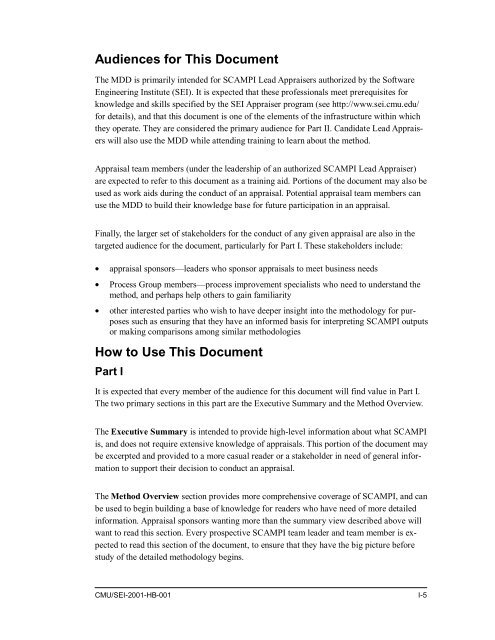Standard CMMI Appraisal Method for Process Improvement (SCAMPI)
Standard CMMI Appraisal Method for Process Improvement (SCAMPI)
Standard CMMI Appraisal Method for Process Improvement (SCAMPI)
Create successful ePaper yourself
Turn your PDF publications into a flip-book with our unique Google optimized e-Paper software.
Audiences <strong>for</strong> This Document<br />
The MDD is primarily intended <strong>for</strong> <strong>SCAMPI</strong> Lead Appraisers authorized by the Software<br />
Engineering Institute (SEI). It is expected that these professionals meet prerequisites <strong>for</strong><br />
knowledge and skills specified by the SEI Appraiser program (see http://www.sei.cmu.edu/<br />
<strong>for</strong> details), and that this document is one of the elements of the infrastructure within which<br />
they operate. They are considered the primary audience <strong>for</strong> Part II. Candidate Lead Appraisers<br />
will also use the MDD while attending training to learn about the method.<br />
<strong>Appraisal</strong> team members (under the leadership of an authorized <strong>SCAMPI</strong> Lead Appraiser)<br />
are expected to refer to this document as a training aid. Portions of the document may also be<br />
used as work aids during the conduct of an appraisal. Potential appraisal team members can<br />
use the MDD to build their knowledge base <strong>for</strong> future participation in an appraisal.<br />
Finally, the larger set of stakeholders <strong>for</strong> the conduct of any given appraisal are also in the<br />
targeted audience <strong>for</strong> the document, particularly <strong>for</strong> Part I. These stakeholders include:<br />
• appraisal sponsors—leaders who sponsor appraisals to meet business needs<br />
• <strong>Process</strong> Group members—process improvement specialists who need to understand the<br />
method, and perhaps help others to gain familiarity<br />
• other interested parties who wish to have deeper insight into the methodology <strong>for</strong> purposes<br />
such as ensuring that they have an in<strong>for</strong>med basis <strong>for</strong> interpreting <strong>SCAMPI</strong> outputs<br />
or making comparisons among similar methodologies<br />
How to Use This Document<br />
Part I<br />
It is expected that every member of the audience <strong>for</strong> this document will find value in Part I.<br />
The two primary sections in this part are the Executive Summary and the <strong>Method</strong> Overview.<br />
The Executive Summary is intended to provide high-level in<strong>for</strong>mation about what <strong>SCAMPI</strong><br />
is, and does not require extensive knowledge of appraisals. This portion of the document may<br />
be excerpted and provided to a more casual reader or a stakeholder in need of general in<strong>for</strong>mation<br />
to support their decision to conduct an appraisal.<br />
The <strong>Method</strong> Overview section provides more comprehensive coverage of <strong>SCAMPI</strong>, and can<br />
be used to begin building a base of knowledge <strong>for</strong> readers who have need of more detailed<br />
in<strong>for</strong>mation. <strong>Appraisal</strong> sponsors wanting more than the summary view described above will<br />
want to read this section. Every prospective <strong>SCAMPI</strong> team leader and team member is expected<br />
to read this section of the document, to ensure that they have the big picture be<strong>for</strong>e<br />
study of the detailed methodology begins.<br />
CMU/SEI-2001-HB-001 I-5
















